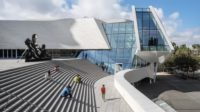Mullingar, Ireland
The Westmeath County Buildings and Library, in the town of Mullingar, express the ambitious political and social agenda that held sway in Ireland in the first decade of the 21st century, before the country’s economic bubble collapsed. In those years, fueled by a rapidly growing economy and a belief in governmental decentralization, Ireland built a series of new administrative and cultural centers across the nation’s 26 counties with the goal of making state facilities more accessible and visible to the public.
Bucholz McEvoy Architects, a Dublin-based firm led by American Merritt Bucholz and Dubliner Karen McEvoy, has designed three of these complexes — in Fingal/North County Dublin [RECORD, August 2001, page 98], County Limerick [RECORD, March 2007, page 140], and now Westmeath, which opened in June 2009.
At Mullingar, Bucholz McEvoy had to incorporate some not particularly significant 19th- and 20th-century buildings into a plan that would include a new boomerang-shaped office block and a 25,000-square-foot public library extending out from a central atrium “like a pulled-out drawer,” the architects say.
By placing the library at a strategic junction in the 100,000-square-foot complex, the architects used it as a pivot in a collage of old and new elements. The library fans out laterally, away from the atrium and its views of the old buildings, and looks out through generous floor-to-ceiling glazing to a small public park to the east, with trees and a stream. “The library had to address the park,” says Bucholz.
The site drops from north to south, taking visitors from the stone-faced county building, constructed before Ireland won independence in 1921, down between surviving fragments – described frankly by McEvoy as “unloved” – of a prison built by British authorities in the early 19th century. This descent across the property serves also as a transition between the town center to the north and the countryside to the south. To the west lies an undistinguished zone allocated to future commercial development.
A wavelike roof sits above the complex’s curving glass entry facade and is held in place by an external web of thin laminated-wood beams. Inside, narrow trays of offices open onto the sun-filled atrium and are equipped with simple linen shutters to control the daylight. The offices also look south through a double-glass membrane, its outer layer serrated in plan to provide acoustic protection from a nearby railway. The architects emphasize that this wall assembly is not a vertical void working as a chimney for air, but is instead made of contiguous horizontal compartments. Some portions of the south elevation are protected by a checkerboard of vertical metal panels and metal mesh.
Because of the site’s change in grade from north to south, the architects were able to exploit sectional opportunities. Characterizing the library as a “floating volume” within the larger group of functions, Bucholz and McEvoy made it accessible at several points in both plan and section. From the town center, visitors approach the library from the old county building (now refurbished to accommodate a council chamber) and cross a concrete footbridge (spanning a broad flight of steps that leads below to the project’s main, curving facade). High above this complex landscape, another bridging element, a truss enclosed in glass, connects the county building to a suite of senior managerial offices above the library.
Visitors either enter the library from the concrete footbridge on the second level or go to the ground-floor atrium, where they can engage county agencies dealing with housing, planning, and motor vehicle issues, then climb a ribbonlike internal staircase to the library entrance on the second floor. Inside, meeting rooms hug the atrium side, while on the other side a double-height reading room rises to clerestory windows.
A staff canteen above provides access to a roof terrace where people can look down into the library through the clerestories.
As they do in all their projects, Bucholz and McEvoy took a straightforward approach to materials here, exposing concrete ceilings and protecting outer facades with vertical timber baffles. Light fittings hang simply from the ceiling. The information desk, or command control, adds a cheeky splash of color, with green and yellow enamel panels facing the landscape and red and pink ones facing the books, McEvoy says.
The architects have earned a reputation for designing environmentally responsive buildings in collaboration with talented consultants. At Westmeath, they worked with Paris-based RFR on the complex’s curving glass facade and with Stuttgart, Germany–based Transsolar on making the building entirely naturally ventilated.
Favored by senior citizens in the morning and kids in the afternoon, the Westmeath library acts as an informal hub for social interaction. As Bucholz explains, the architects used the library as the centerpiece of the county complex to “foreground its role in civic life.”
Raymund Ryan is curator of the Heinz Architectural Center at the Carnegie Museum of Art in Pittsburgh, where his recent exhibitions include Design Competition: New Cottages at Fallingwater and Gritty Brits: New London Architecture.
Architect:
Bucholz McEvoy Architects
Location: Mullingar, Ireland
Completion Date: July 2009
Gross square footage: 100,000 sq. ft. (complex); 25,000 sq. ft. (library)
Total construction cost: $43 million
PeopleOwner Architect Personnel in architect's firm who should receive special credit: Engineer(s) Mechanical & Electrical Engineers: Atrium Structure & Facade Engineers: Structural Engineers, Concrete Building Frame: Consultant(s) Other: General contractor Photographer(s) CAD system, project management, or other software used |
ProductsStructural system: In-situ concrete frame. Manufacturer of any structural components unique to this project: Specialist Timber structures: Exterior cladding Structural Timber façade, timber components Curtain wall: Other cladding unique to this project: External fabric blinds: Windows Interior finishes Paneling: |








Post a comment to this article
Report Abusive Comment